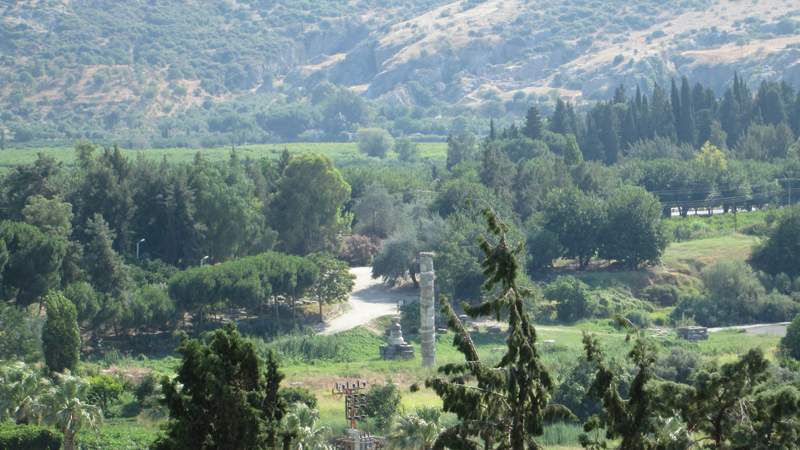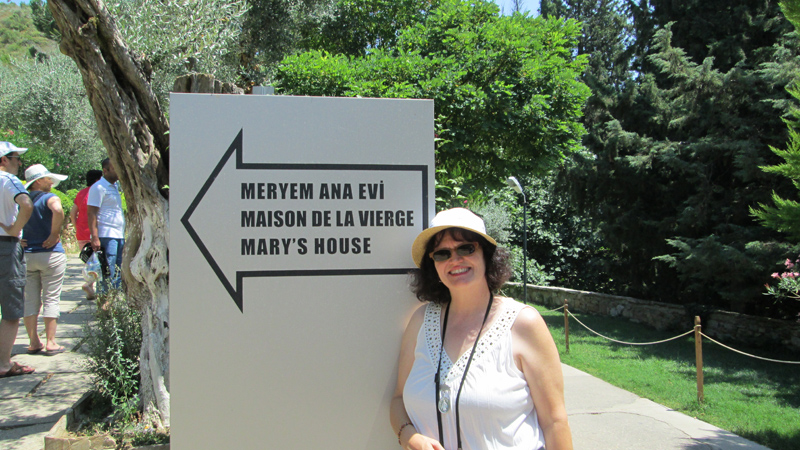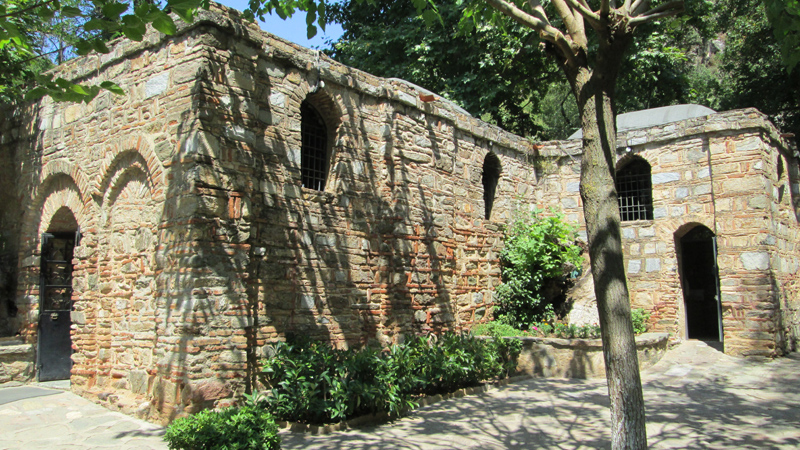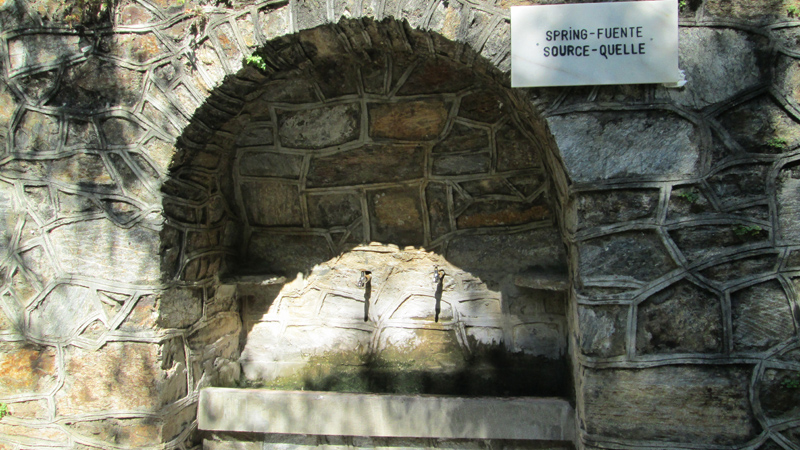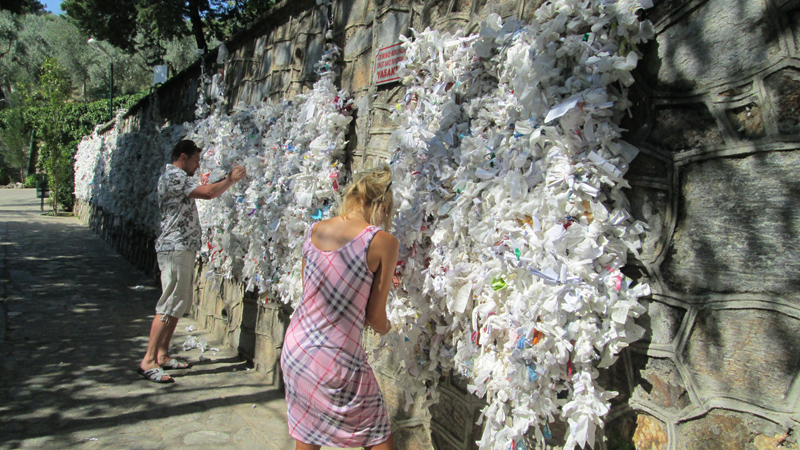|
Medjugorje
Message: July 25, 2012
|
|
Published
by the Marian Center of San Antonio / A Catholic Evangelization Ministry
Our Lady’s message this month is rich in spiritual teaching. She
calls us to “the good.” St. Paul famously wrote: “Do not be overcome by evil but
overcome evil with good.” (Rom 12:21) Our Lady’s teaching is the same. In a culture that is often
oppressively dark, negative, sinful, and violent, she exhorts us to “Be
carriers of peace and goodness in this world.” This is a call to live in a radically
countercultural way that must begin in our deepest interior recesses, at
the spiritual headwaters of our thinking, feeling, speaking, and acting. It
is not something we can “fake” or project at a superficial level without
authenticity, but must be rooted in the heart where peace and goodness find their source in the Source who is God.
Our Lady’s message continues: “Pray that God may give you the strength
so that hope and pride may always reign in your heart and life because
you are God’s children and carriers of His hope to this world that is without
joy in the heart, and is without a future, because it does not have its heart
open to God who is your salvation.” This one long sentence holds the
substance of Our Lady’s teaching, with several important points clearly
linked together. First of all, we must have “strength” from God in order for “hope and pride” to always reign in our heart and life. At this point, we may be
stopped in our tracks by a perplexing question: How can Our Lady be praising
or inviting us to an attitude of “pride”? Isn’t pride the downfall of the human race and the sin that caused
Satan to “fall like lightning” from heaven?
We must read these words in context. Our Lady says we should
pray for strength “so that hope and pride may always reign in your heart and
life because you are God’s children and
carriers of His hope to this world….” Our
“pride” is not the false pride of the egoic lower
self, based on grandiose illusions rooted in fear and insecurity. Our pride
is the high-minded confidence we should rightfully have as children of God who carry the divine Hope and action into
the world through God’s own Indwelling Presence within us—the Holy Spirit
animating our souls. St. Paul wrote: “May the eyes of your hearts be
enlightened, that you may know what is the hope that belongs to his
call, what are the riches of glory in his inheritance among the holy
ones, and what is the surpassing greatness of his power for us who
believe.” (Eph 1:18)
Our Lady realizes that our call to the “good” as “carriers of
goodness” in the world will be futile, meaningless and impossible if we are
mired in a false humility that keeps us convinced of our own worthlessness. This is not true
humility at all, but a satanic ruse by which even devout Christians
are often diverted from the truth of their royal status as Spirit-filled
children of God, and prevented from being lights to the world. Such false
humility is the devil’s own “bushel basket” with which we cover and conceal
our light, preventing it from shining brightly in the world of darkness. Our
Lady calls us to recognize and appreciate our human
value, dignity, and self-worth as
children of the God who is Love. (This has no connection to some forms of
worldly “self-esteem building” that are based on nothing but the vanity of
the False Self system or the satanic ego.)
Closely connected to the “good” and being “carriers of peace and
goodness in this world” is the presence of “joy
in the heart.” Our Lady says that this
world “is without joy in the heart, and without a future, because it
does not have its heart open to God who is your salvation.” Without awareness
of the Divine Indwelling presence of God at the center of the human person,
we have no ability to feel true joy—only the unending experience of craving safety and security,
affection and esteem, power and control, and the temporary “fixes” for these
addictive desires that our culture provides, always ending in disappointment
and failure to fill the “God-shaped hole” in our heart. Oblivious to what
truly satisfies—God alone—we have created a self-destructive world of superficiality that, as
Our Lady says, “is without a future.” It is going nowhere, like the dead
branches that—disconnected from the life-giving Vine—are good for nothing but
to be thrown into the fire. (Mt 3:10, Jn
15:6) But for us, it must be different and we are meant to lead the way
out of darkness by blazing a path of light toward higher spiritual
consciousness for our brothers and sisters.
Some time ago, Our Lady gave
a teaching to the Prayer Group in Medjugorje
regarding pride, humility, and joy, and the notes taken by Jelena (one of the two locutionists)
are illuminating for this month’s message: “Regarding sin, it suffices to
give it serious consideration, and soon move ahead and correct the sin. Your
humility must be proud or high-minded. Your pride should be humble.
If you have received a gift from God, you must be proud, but do not say that
it is yours. Say rather that it is God’s.” Our Lady taught:
“Dear children, you cannot
understand my messages or anything else because you torment yourselves too
much. You choke the joy that springs in you. One should not dwell on
the analysis of sins too long. Two minutes are enough. One should unburden
oneself of this before prayer in
order to be able to enter into prayer. You think that you are humble when you
say to yourselves, ‘Oh, how wicked I am!’ No, no—it is better to be haughty
or proud, for at least one rejoices, than to
be depressed, that is, to have no joy at all. Yes, I was humble, but I was
never without joy. You are not humble, although you often think that
you are. If you reasoned like this: ‘Well, I have made a good progress today.
I have overcome this, I have overcome that, joy would be born in you,
and the next day you could overcome something else. But you say, ‘Oh, what a
fault I have made!’ and you are always hard on yourselves for not having
succeeded in anything. This chokes you to such a degree that you cannot
amend anything. Therefore, say to yourselves: ‘Today I have rejoiced a
bit more.’ Tomorrow you will find more joy in doing something else. But if
you keep repeating, ‘I am a failure, I am a failure,’ you will never achieve
anything. That is why you have to be proud to some extent. But that is not
haughtiness; only you think it is haughtiness. You must be humble in your
pride and proud in your humbleness.” This is the “both/and” teaching
of Our Strong and Joyful Mother……Mary—Humble and Assumed into Heaven!
August
Musings . . .
. . . Visiting Mary’s House in Ephesus, Turkey—Site of Her last years on
Earth & her Glorious Assumption into Heaven
“Come on-a my house, my house, I’m-a gonna give you candy. Come on-a my
house, my house, I’m-a gonna give you an apple and
a plum and an apricot or two, ah! Come on-a my
house, my house, come on. Come on-a my house, my
house-a come on. Come on-a my house, my house, I’m gonna
give you figs and dates and grapes and a cake, ah!...
Come on-a my house, my house, I’m gonna give you a
Christmas tree. Come on-a my house, my house,
I’m gonna give you marriage ring and a pomegranate,
too, ah! Come on-a
my house, my house-a, come on, Come on-a my house, my house-a come on…
Come on-a my house, my house, I’m gonna give you an
Easter egg. Come on-a my house, my house, I’m-a gonna give you everything,
everything, everything.”
– William Saroyan, 1939, sung by Rosemary Clooney (1951) &
Bette Midler (2003)
I recently had the
extraordinary privilege of visiting “Meryem Ana,”
the house of Our Blessed Mother Mary near Ephesus, Turkey. Spending a couple of
afternoon hours in Mary’s house was a grace and blessing I will never
forget. The House of Mary was
discovered in 1891 by two Lazarist priests guided
by the writings of the German mystic, Anne-Catherine Emmerich.
Her book, The Life of the Virgin Mary,
described in detail mystical visions of the house of Ephesus where Our Lady
was taken by the Apostle John to live out the final years of her life in
relative safety from persecution, while he wrote in exile on the nearby Greek
island of Patmos. The site discovered by Fr. Poulin
and Fr. Jung on Nightingale Hill matched Anne-Catherine Emmerich’s
description precisely: “Mary’s house was the only one built of stone. A
little way behind it was the summit of a rocky hill from which one could see
over the trees and hills to Ephesus and the sea with its many islands….The
district is lonely and unfrequented.” On the day I visited, Mary’s House was
filled with a steady stream of her children from all over the world, and from
various religious traditions.
Pre-Christian Ephesus was
famous for one of the seven wonders of the world—the Temple of Artemis (a many-breasted goddess of fertility)—and had
been one of the greatest cities of the East. Christian Ephesus was likewise
famous for its early-church community that facilitated the evangelization of
people all over Asia through the New Testament writings that were drafted
there: 1 Corinthians, Philippians, Galatians, the Gospel of John and Letters
of St. John. It was one of the most important of the Seven Churches of the
Book of Revelation and the recipient of Paul’s Letter to the Ephesians. It
was significant for the presence of Mary, St. John the Apostle/Evangelist
(the Beloved Disciple), St. Paul, St. Mary Magdalen,
St. Timothy and other luminaries of the early Church. The famous third
ecumenical Council of Ephesus was held there in 431, where the controversial
doctrine of “Mary Theotokos” was proclaimed:
that the Virgin Mary’s title was indeed “Mother of God.” The tomb of St. John the Evangelist was
reportedly found beneath St. John’s Basilica in Ephesus—the only one of the
twelve apostles who died a natural death in old age rather than being
martyred.
The Lazirist
priests of 1891 were led to the ruins of Mary’s house (which was by then a
small chapel) by terrible thirst on their expedition. Some local women
working tobacco fields pointed them toward a spring of water in a clump of
trees across a field called “Panaya Kapulu,” meaning “Gate
of the Virgin.” Hidden in the trees near this pure spring was Our Lady’s
dwelling place. Long before the priests arrived, the local Christians had for
generations venerated this site and held pilgrimage festivals on August 15 to
celebrate the Dormition and Assumption of Mary into
heaven. In addition to this site, there are 33 other churches in the area
dedicated to the Blessed Virgin Mary.
The attitude of the Popes
has been positive since the discovery of Meryem
Ana, with Popes Paul VI, John Paul II, and Benedict XVI actually visiting the
shrine and offering Mass there. Pope Benedict XVI, upon his visit there,
said, “From here in Ephesus, city
blessed by the presence of the Holy Mother, loved and venerated also by
Muslims, we raise a special prayer for peace among nations.” In 1896,
Pope Leo XIII stripped “Mary’s Tomb” in Jerusalem of all its indulgences,
which have now been transferred to the House in Ephesus. There is an outdoor
platform near the house with an altar where Mass is celebrated every Sunday.
In addition, the Franciscans who care for the shrine offer Mass and pray
Lauds and Vespers daily.
Meryem Ana (Mother Mary’s
House) is a holy site of pilgrimage and prayer for Muslims, too. When exiting
Mary’s Chamber to the right of the main chapel, there is a display of
extracts from the Koran that speak of Mary, whose name is mentioned 34 times
in the sacred scripture of Islam. The Koran says that she is the only woman
not touched by Satan; that she was a virgin when she gave birth to Jesus
because of a word pronounced by God through the angel Gabriel (Jibral); and that she died and was lifted to a high place
with her son Jesus. Many Muslims come
to pray at Mary’s House, bringing their prayer rugs and spending hours in
meditation. (I saw some, and our guide said that in general, the Muslim
pilgrims show more prayerful devotion to Our Lady than the Christian visitors
do. Sad but probably true.) An
association of volunteer Christians and Muslims runs the small gift shop near
the outdoor springs, which is the sole support for upkeep of Meryem Ana, along with a box for offerings inside the
chapel. Many have claimed cures and healings from drinking the water of the
springs at Mary’s House. Upon exiting, there is a small bank with
water faucets where one may drink, wash, and fill bottles with this pure
spring water that flows beneath the house. Alongside the springs is a rock
wall filled with hundreds of thousands
of small white paper prayer petitions that pilgrims leave, reminding one of
the Western Wall of the Temple in Jerusalem. There is also an outdoor candelarium where one can light candles.
My experience at Mary’s House was similar to that
in other great Marian shrines of the world, such as Medjugorje,
Lourdes, and Fatima: a great feeling of peace and serenity, and the sense of a loving, gentle, compassionate presence enveloping all who walk the shady path to the
small, simple, humble stone house, and enter its doors. The curved archways
and high windows letting in light create an atmosphere of openness and unconditional acceptance, mercy, hospitality,
motherly love and care,
and the invitation to receive all the things made possible by Mary’s “yes” —“a Christmas tree, an Easter egg, and
everything, everything, everything.”
(To see photos of Mary’s House, please scroll down!)
|
Mark Your Calendar
|
August
6 |
Transfiguration of the Lord (4th Luminous Mystery of the
Rosary)
|
|
7-9
|
Class:
“Consolation for Scattered Communities: The Letters of Peter, John, and Jude”
with Tim Milinovich, PhD; 9:30 am-12 noon, SoL Center, 300 Bushnell Ave, $30 for 3 sessions; call
732-9927
|
|
8
|
Free
Concert: “Good for the Soul” with David Kauffman & Bill Gokelman; 7 pm, Whitley Theological Center, Oblate School
of Theology, 285 Oblate Dr.
|
|
9
|
6-week
Course: “Faithful Citizenship—An Exploration of Scripture &
Tradition,” for forming consciences
for responsible political participation according to Catholic social teaching;Thursdays, 7-9 pm, St. Brigid’s
Church, 6907 Kitchener
|
|
11
|
St. Clare of Assisi
Interfaith Discussion: “When Mystic Masters
Meet: Towards a New Matrix for Christian-Muslim Dialogue” (ch. 4, “Meister Eckhart on Detachment”); 2-4 pm, Viva!
Bookstore, 8407 Broadway
|
|
15
|
The
Assumption of the Blessed Virgin Mary (4th Glorious Mystery of the Rosary)
|
|
16
|
12-week Discussion on Compassion based on
the book, Twelve Steps to a
Compassionate Life by Karen Armstrong; led by Rosalyn Collier of peaceCENTER; 10 am-12 noon, Thursdays thru Oct. 1; Viva!
Bookstore, 8407 Broadway; $5 per session
|
|
18
|
Workshop: “Our Evolving Soul,” with Solus Meek; 3-5 pm, Viva! Bookstore, 8407 Broadway; $25
including workbook/handouts
|
|
22
|
The Queenship of
the Blessed Virgin Mary (5th Glorious Mystery of the Rosary)
|
|
25
|
Peace Mass: 12 pm, St. Mary’s Church, 202 N.
St. Mary’s; 11:30 am Rosary
|
|
25-26
|
Fullness
of Truth Catholic Conference: “Why the Cross?”—The Meaning of Suffering, with
Dr. Scott Hahn & other speakers, Mass, adoration, Sacrament of
Reconciliation, music, etc.; Hyatt Hill Country Resort; call 1-877-21-TRUTH
|
|
26 |
St. Joachim & St. Anne, parents of
Blessed Virgin Mary
|
|
28
|
St. Augustine
|
|
28
|
“School of Prayer” covering 5 different ways
of praying—Lectio Divina,
The Jesus Prayer/Mantra, Body Prayer/Taize, Ignatian Contemplation, Centering Prayer; 5 Tuesdays, 7-9
pm, Oblate School of Theology Whitley Theological Center, 285 Oblate Dr.;
$50; call Brenda—341-1366 x 212
|
|
30
|
Course: “Bridges to Contemplative Living
with Thomas Merton: Adjusting Your Life’s Vision”; 9 Thursdays thru Oct. 25,
1-3 pm, Oblate School of Theology, 285 Oblate Dr.; call Brenda at
210-341-1366 x 212
|
|
“As we sit in the palm of your hand,
loving God, may we continue to see your strength revealed in the
vulnerability, the dying, the crying, the rising of
your people. May our seeing inspire our acting. Amen.”
--
Katherine Hawker
|
Copyright, Marian Center of San Antonio. All rights reserved. No part of this newsletter may be reproduced without permission.
